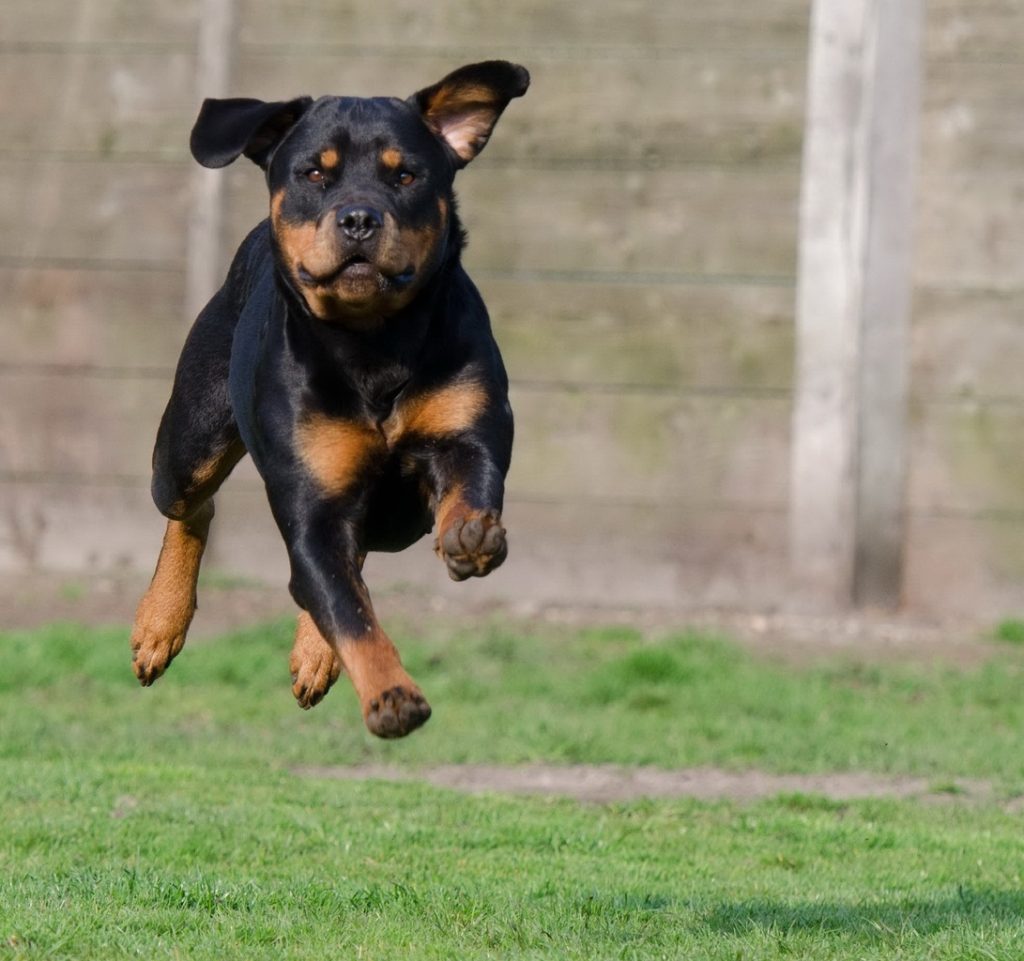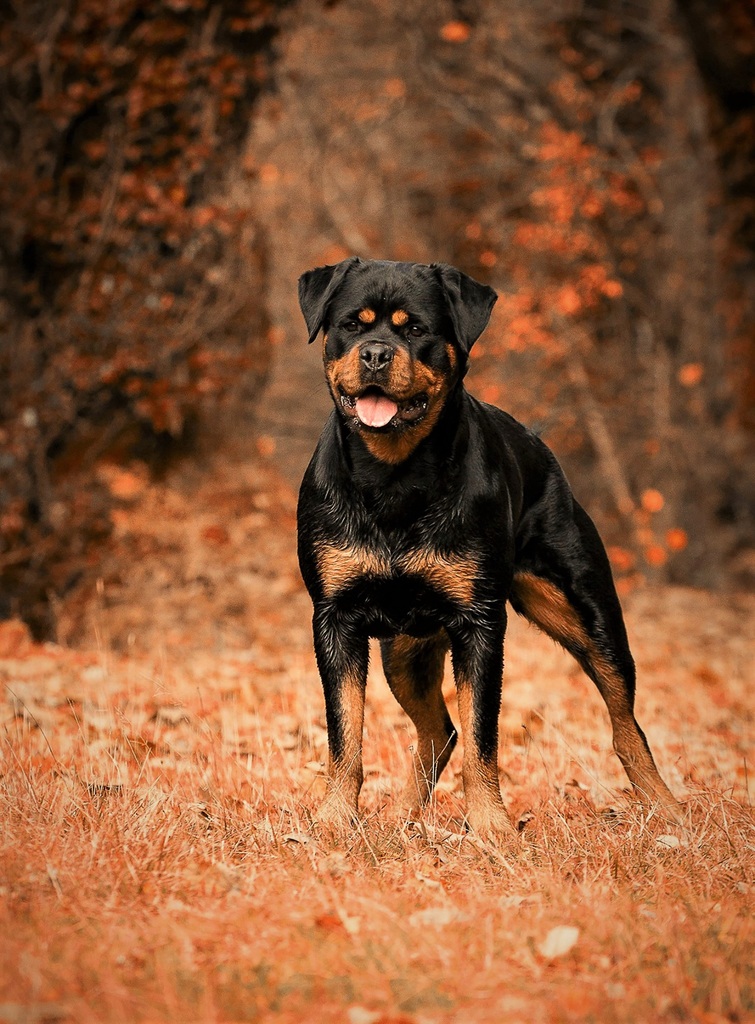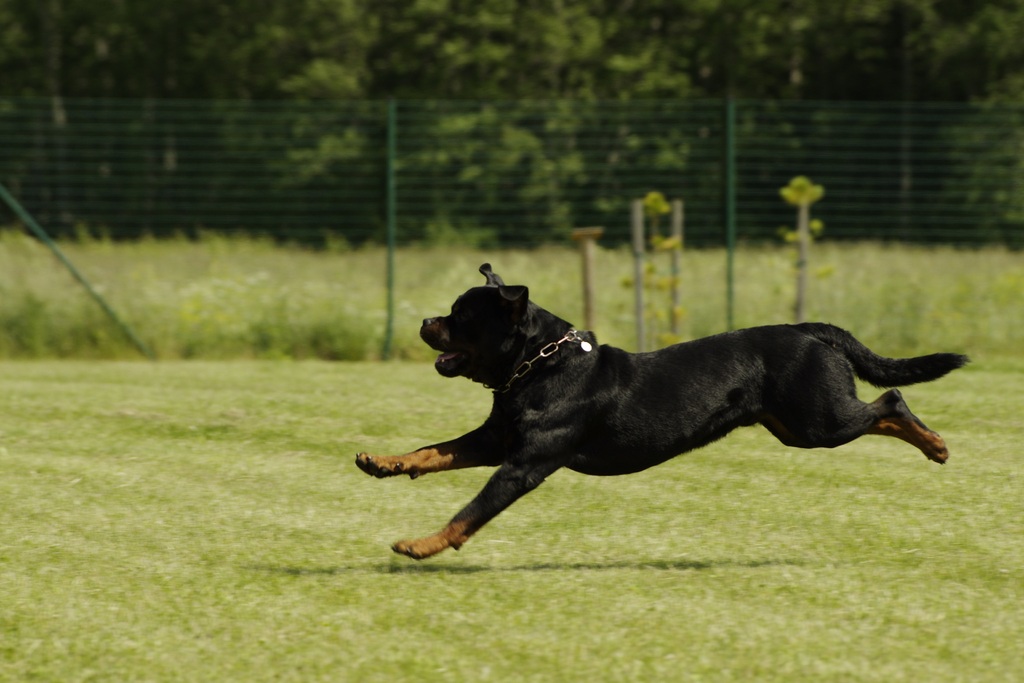The Rottweiler, a breed known for its strength, loyalty, and intelligence, is much more than a formidable guardian; it’s a versatile, affectionate, and dependable companion. This article delves into the world of Rottweilers, offering insights into their nature, the importance of early and consistent training, and best practices for raising a well-behaved and happy dog. From understanding the unique traits of this majestic breed to mastering advanced training techniques, we will explore the essential steps in nurturing a robust and respectful bond between you and your Rottweiler. Whether you’re a new owner or looking to deepen your knowledge, this guide will help you on your journey with these magnificent animals, ensuring a harmonious and rewarding relationship.

Understanding Rottweilers
Nature and Traits of a Rottweiler
Rottweilers are known for their robust physique, marked by a broad chest and a powerful, muscular build. Historically bred for herding and guarding, they exude strength and confidence. Despite their formidable appearance, Rottweilers are often calm and loyal, especially towards their family members. They are intelligent dogs, capable of complex training and problem-solving.
This breed’s temperament is a blend of affection and independence. Rottweilers are known for fiercely loyal to their family, often forming a solid bond with a single person. They can be reserved, even aloof, with strangers, making socialization and training essential to help them distinguish between normal and threatening behaviors.
Their intelligence and a natural inclination for dominance require an owner who can provide firm, consistent leadership. Rottweilers respond well to fair and respectful commands, requiring regular mental and physical stimulation to stay balanced and happy.
The Importance of Early Training
Early training for a Rottweiler is not just a matter of obedience; it’s crucial for their overall development and integration into family life. The breed’s intelligence and strength can become challenging if not directed positively from a young age. Training helps nurture a Rottweiler’s social skills, teaching them how to interact appropriately with people and other animals.
The importance of establishing boundaries cannot be overstated. Rottweilers need to understand their place in the family hierarchy. Training that starts early helps curb undesirable behaviors like excessive barking, chewing, or aggression. It also aids in building their confidence and trust, making them more adaptable and well-rounded as they grow.
Training should combine basic obedience, socialization, and exposure to various environments and stimuli. This holistic approach ensures that the Rottweiler grows into a well-adjusted adult, capable of efficiently handling different situations.
Essential Rottweiler Training Steps
Starting Training in Puppyhood

The foundation of a well-behaved Rottweiler is laid during its puppyhood. This period is critical as puppies are more receptive to learning and adapting. Training should begin as soon as the puppy arrives home. Basic obedience – like sitting, staying, coming, and housebreaking – lays the groundwork for more advanced training later on.
It’s also a time to start instilling good habits. This includes crate training, which helps housebreaking and provides a safe space for the puppy. Leash training is another essential aspect, teaching the puppy to walk calmly beside you without pulling.
Early training also encompasses teaching the puppy to respond to its name and get accustomed to being handled, which is vital for grooming and veterinary care. It’s essential to keep these training sessions short, fun, and positive, as puppies have short attention spans.
Recognizing and Handling Dominance
Recognizing and appropriately handling dominance in Rottweilers is vital. This breed can exhibit dominant behaviors, which, if not managed, can lead to challenges in control and obedience. The key to managing dominance is establishing yourself as the pack leader respectfully and confidently.
Leadership is about setting boundaries and rules consistently. It’s not about being harsh or aggressive but about being assertive and calm. A Rottweiler should understand that you control resources like food, toys, and walks. This helps in establishing your position in the hierarchy.
Training should be a mix of discipline and reward. While correcting undesirable behaviors is essential, it’s equally important to praise and reward the dog for obedience and good behavior. This balanced approach ensures that the Rottweiler respects and trusts your leadership.
Effective Socialization Techniques
Socialization is the process of exposing your Rottweiler to a variety of experiences, environments, people, and animals. It is critical for developing a well-adjusted, confident dog. Adequate socialization should start early and continue throughout the dog’s life.
Exposure to different situations in a controlled, positive manner is critical. This includes meeting new people of all ages, encountering other animals, and experiencing various sounds and environments. Each positive encounter helps the puppy cope with new experiences without fear or aggression.
Socialization also involves teaching the puppy how to behave in different settings. This includes behaving calmly in public, being gentle with children, and being comfortable with routine activities like vet visits and grooming. The goal is to have a well-mannered and confident dog in various settings.
Core Principles to Train a Rottweiler
The core training principles for Rottweilers revolve around understanding and harnessing their instincts, intelligence, and temperament. Central to these principles is positive reinforcement, a method proven effective with this breed. Positive reinforcement involves rewarding desired behaviors and encouraging the dog to repeat these behaviors. The rewards can be in various forms, such as treats, praise, or playtime, depending on the individual dog’s motivation. This approach strengthens the bond between the owner and the Rottweiler and fosters a positive learning environment. Key to its success is consistency and timing; rewards must be given immediately following the desired behavior to ensure the dog makes the correct association. This method nurtures a sense of trust and cooperation, which is essential for practical training.
Conversely, harmful discipline methods, such as harsh reprimands or physical punishment, are counterproductive and can lead to fear, anxiety, or even aggression in Rottweilers. These intelligent and sensitive dogs respond better to a calm, assertive approach rather than intimidation. It’s crucial to establish leadership and respect without instilling fear. Another vital principle is the timeliness of feedback. Dogs live in the moment, and delayed reactions can confuse them, making it difficult to understand what they are being praised or corrected for. Immediate and consistent feedback helps the dog to understand which actions are acceptable and which are not clearly. By adhering to these core principles, training becomes a rewarding experience, enhancing the natural abilities of the Rottweiler and fostering a respectful and obedient companion.
Emphasizing Positive Reinforcement
Positive reinforcement is a powerful tool in Rottweiler training. This method reinforces good behavior by rewarding the dog when it performs the desired action.
- Rewards can be treats, praise, petting, or playtime – anything the dog finds enjoyable.
- The key is to reward the dog immediately after the desired behavior to reinforce the connection between the action and the reward.
- Over time, this positive reinforcement shapes the dog’s behavior, encouraging them to repeat the actions that earn them rewards.
Avoiding Negative Discipline Methods
- Negative discipline, such as scolding, physical punishment, or isolation, can adversely affect a Rottweiler’s temperament and trust in their owner.
- These methods can induce fear, anxiety, and sometimes aggression, which is counterproductive to training.
- Instead, redirect unwanted behavior towards positive actions and reinforce these with rewards.
Timeliness in Responding to Behaviors
- Immediate feedback is crucial. Dogs associate actions with consequences (rewards or corrections) only if given shortly after the behavior.
- Delayed reactions can lead to clarity and help the learning process.
- Consistency in response helps the dog understand which behaviors are encouraged and which are discouraged.
Basic Command Dog Training

Teaching ‘Sit’ and ‘Stay’
The ‘Sit’ and ‘Stay’ commands are fundamental in dog training. Teaching a Rottweiler these commands establishes a foundation for more complex instructions.
- Teaching ‘Sit’: Hold a treat close to your dog’s nose and move your hand up, encouraging its head to follow the treat and causing its bottom to lower. Once sitting, say “Sit,” give the treat, and praise the dog.
- Teaching ‘Stay’: After your dog sits, show the palm of your hand and say “Stay.” Take a few steps back, rewarding the dog for staying put. Gradually increase the distance and duration of the stay.
‘Paw’ and ‘No’ Commands
Teaching ‘Paw’ and ‘No’ commands are essential for basic obedience and control.
- Teaching ‘Paw’: With your dog sitting, hold a treat in your hand and say “Paw” while gently tapping one of their paws. Most dogs will naturally lift their paw towards your hand. Reward them with the treat once they do so.
- Teaching ‘No’: The ‘No’ command is crucial for stopping unwanted behaviors. Use a firm (but not angry) tone. Reward the dog when it stops the unwanted behavior and follows your command.
‘Down’ and ‘Come’ Instructions
‘Down’ and ‘Come’ enhance your control and your dog’s safety.
- Teaching ‘Down’: With a treat in hand, bring it to your dog’s nose and lower it to the floor, encouraging your dog to follow. Slide your hand along the ground, leading them into a ‘down’ position, and reward them upon success.
- Teaching ‘Come’: This command is crucial for recall. Start with a leash and collar. Say “Come” while gently pulling on the leash. Reward your dog when it comes to you, gradually increasing the distance over time.
Advanced Strategies for Training Rottweiler Behavior
Patience in Training Your Rottweiler
Training a rottie, particularly at an advanced level, demands exceptional patience. This breed’s intelligence and independence sometimes translate into stubbornness during training sessions. Remembering that progress may be gradual and celebrating small victories is crucial. Maintaining a calm and assertive demeanor helps in establishing authority and trust. The key is to be persistent and consistent, understanding that advanced essentials are a gradual process that builds on the foundation of basic training principles.
Crate and Clicker Training Methods
Crate training is essential to providing a safe and comfortable space for your Rottweiler. The crate should be a place of security, not punishment. Introducing the crate as a positive space involves gradual acclimatization, using treats and positive robust reinforcement to build a favorable association. Clicker training, on the other hand, is an effective method to mark desired behaviors precisely. The click sound is a consistent and clear marker of correct behavior, followed immediately by a reward. This method is especially useful in advanced training as it communicates to the dog the exact moment they perform a desired action, thus speeding up the learning process.
Advanced Obedience Techniques

Advanced obedience training for Rottweilers goes beyond basic commands and delves into more complex tasks and behaviors. This includes off-leash training, mastering commands like ‘heel,’ ‘fetch,’ and ‘stay’ under various distractions, and even learning hand signals. Training at this level requires a deeper understanding of canine psychology and behavior. It often necessitates longer, more focused training sessions and sometimes the guidance of a professional dog trainer. Advanced obedience emphasizes refining the dog’s skills and responsiveness in various situations, ensuring that the dog remains well-behaved even in challenging environments.
The Chapractical Training Rottweilers
With their solid and independent nature, Rottweilers present unique training challenges. They often test boundaries and may exhibit dominant behaviors, requiring a supportive and knowledgeable trainer. The challenge lies not in their capacity to learn, which is considerable, but in ensuring that their training is consistent, engaging, and assertive without being confrontational. The goal is to earn their respect and loyalty, making them more amenable to training.
Ideal Age for Starting Training
While Rottweilers can learn at any age, the ideal time to begin advanced training is after they fully grasp basic commands and obedience. This typically occurs around the age of 6 months to a year. Their cognitive abilities are sufficiently developed at this stage to understand more complex commands and behaviors. It’s also a time when they can be more receptive to training, allowing for the establishment of more nuanced behaviors and commands.
Best Training Practices for Rottweilers
The best practices for training Rottweilers include a blend of consistency, positive reinforcement, and understanding of the breed’s unique characteristics. Training sessions should be consistent regarding commands used, rewards given, and expectations set. Positive reinforcement remains key, encouraging good behavior through rewards and praise. Understanding the breed involves recognizing their need for mental stimulation, physical exercise, and a clear pack structure. Training should be disciplined and fun, ensuring the Rottweiler remains engaged and motivated to learn.
Behavioral Management: Habits, Socialize
Curbing Growling and Biting in Puppies
Puppies naturally explore their environment and communicate through biting and growling, but teaching them appropriate behavior is essential.
- Understanding the Behavior: Recognize that biting and growling are normal puppy behaviors used for playing and exploring.
- Redirecting to Appropriate Activities: Whenever the puppy begins to bite, redirect its attention to a toy or a chewable item.
- Consistency Across the Household: Ensure everyone uses the same commands and techniques to address biting, creating a consistent learning environment.
Preventing Destructive Eating Habits
Due to their size and strength, destructive eating habits can be problematic with Rottweilers. Effective strategies are needed to prevent and manage these habits.
- Regular Feeding Schedule: Establish a consistent feeding routine to discourage scavenging and begging.
- Providing Suitable Chew Toys: Offering appropriate chew toys can divert attention from household items and help manage the dog’s chewing instinct.
- Training Against Food Aggression: Training your Rottweiler to be calm and non-possessive around food, ensuring safe interactions for the dog and family members.
Socializing Your Rottweiler Effectively
Proper socialization prevents behavioral issues and ensures your Rottweiler is well-adjusted.
- Exposure to Diverse Situations: Gradually introduce your dog to various environments, people, and other animals.
- Positive Reinforcement: Use treats and praise to create positive associations with new experiences and encounters.
- Monitoring and Adjusting the Pace: Observe your dog’s reactions to different situations and adjust the pace of socialization accordingly to avoid overwhelming them.
Training Schedule Table To Avoid Behavior Problems

To provide a clearer idea of how to structure Rottie training, here’s a table outlining a basic training schedule:
| Age Range | Training Focus | Goals and Activities |
| 8-12 weeks | Basic Commands | Sit, Stay, Come, Name Recognition |
| 3-6 months | Socialization | Exposure to people, animals, environments |
| 6-12 months | Advanced Obedience | Heel, Fetch, Responding to hand signals |
| One year onwards | Specialized Training | Agility, specific tasks, behavioral fine-tuning |
The First Two Weeks at Home With Puppy
Establishing Basic Manners
The first two weeks after a Rottweiler puppy arrives at its new home are crucial for setting the tone for future behavior. During this period, it is essential to establish basic manners. This involves introducing the puppy to the rules of the house, like where it can and cannot go, and starting basic training commands like ‘sit’ and ‘no.’ Consistency from all family members in enforcing these rules is critical. This time is also ideal for beginning housebreaking, teaching the puppy where and when to eliminate.
Initiation into Grooming and Nail Care
Grooming and nail care are important aspects of a Rottweiler’s health and well-being. Early initiation into grooming helps the puppy get accustomed to being handled and touched in various ways. This includes regular brushing, bathing, and nail trimming. Getting them used to these activities early on will make it much easier to perform these tasks throughout their life, especially as they grow larger and stronger.
Potty Training Essentials
Potty training is one of the most important aspects of bringing a new puppy home. It requires patience, consistency, and positive reinforcement. Establish a regular schedule for feeding and potty breaks, and take the puppy to the same spot each time. Praise and treats immediately after the puppy is eliminated in the correct spot can reinforce good behavior. Accidents should be expected, but it’s important not to punish the puppy for them. Instead, focus on more frequent potty breaks and supervision to prevent them.
Building a Strong Bond To Train Your Rottweiler
Gaining Respect from Your Rottweiler
Earning respect from a Rottweiler is fundamental for a harmonious relationship. Respect is built through leadership, consistency, and mutual understanding. Establishing yourself as the pack leader calmly and assertively is vital. This doesn’t mean being harsh but showing confidence and consistency in your interactions. Training sessions, playtime, and even regular walks can strengthen the bond and respect between you and your dog.
Consistency and Fairness in Training
Consistency is the cornerstone of effective training. This means using the same commands, rewards, and discipline methods. It helps the dog understand what is expected of them, making training more effective. Fairness is equally important; this involves understanding the dog’s limitations and not expecting more than they can deliver at their current training level. Recognizing and rewarding efforts, even if they aren’t perfect, encourages continued improvement.
Choosing the Right Training Techniques
Selecting the right training techniques for a Rottweiler involves understanding their temperament and learning style. Rottweilers respond well to positive reinforcement and consistent, firm training. It’s important to vary training techniques to keep sessions interesting for them. This could include traditional obedience training, clicker training, and interactive play. Avoid techniques that promote fear or aggression.
Dealing with Aggressive Tendencies in Dogs
Rottweilers sometimes display aggressive tendencies rooted in fear, protection instincts, or lack of socialization. It’s crucial to address these behaviors early on. Training should focus on building confidence and social skills. Exposure to various situations in a controlled manner helps in reducing fear and aggression. Professional help from a dog behaviorist may be necessary for severe cases.
Conclusion
In conclusion, owning and training a Rottweiler is filled with challenges, learning experiences, and immense rewards. With their striking appearance and robust nature, these majestic dogs require a dedicated and thoughtful approach to training and care. Understanding Rottweilers’ unique traits and needs is the first step towards a harmonious and fulfilling relationship with them.
Rottweilers, known for their loyalty and intelligence, thrive in environments where they are given clear guidance, structure, and plenty of love. The bond between a Rottweiler and its owner is profound and deeply rooted in mutual respect and understanding. This bond is not just the result of consistent training but also of the shared experiences and trust that develop over time. The effort put into training, socializing, and caring for a Rottweiler pays off in the form of a well-behaved, confident, and affectionate companion.
The importance of early and ongoing training cannot be overstated. It shapes not only the dog’s behavior but also the personality and emotional well-being. Training a Rottweiler is about more than teaching commands; it’s about communication, understanding, and building a relationship based on mutual respect. It’s also about recognizing the individuality of each dog and adapting training methods to suit their unique temperament and learning style.
Moreover, the role of the owner extends beyond that of a trainer. As a Rottweiler owner, you become your dog’s caretaker, guide, and, most importantly, a lifelong friend. This role comes with responsibilities – ensuring your Rottweiler’s health, safety, and happiness. It’s a journey that requires patience, commitment, and unconditional love. The challenges faced along the way are greatly outweighed by the joy and companionship that a well-trained Rottweiler brings to your life.
